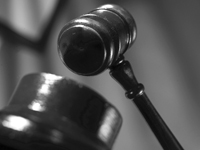The Amerikkkan legal system
It is a decision that will live in infamy. It rivals Dred Scott, which held that African-Americans had no rights that white people were bound to respect, and Plessy vs. Ferguson, which upheld the segregationist doctrine of “separate but equal.” It, for all intents and purposes, destroyed the landmark ruling in Brown vs. Topeka, which declared that “separate but equal” is “inherently unequal.” It is one of the most racist, shortsighted and destructive legal “opinions” in history. Yet it is hidden behind pretentious platitudes about the Constitution of the United States being “color-blind.”

Still it is not surprising that the current United States Supreme Court wasted little time leaving its imprint of evil upon the nation. After all, this was the court that launched the pestilence known as George W. Bush during the coup of 2000.
The constitution has never been “color-blind.” From the “three-fifths” compromise that, for purposes of Congressional representation, counted a slave as three-fifths of a human being, to the “Hayes Compromise” that made the Fourteenth and Fifteenth Amendments nothing more than empty words on paper, to the current decision to resegregate American schools, and eventually American society, the constitution has always been capable of seeing “color.” To think that a history of racism and injustice can be obliterated with a stroke of a pen demonstrates just how clueless these so-called Supreme Court “justices” really are. Or perhaps it is simply that these “justices,” are on the summit of what is probably the most corrupt and unabashedly racist institution in the nation: Amerikkka’s legal system.
This corruption and racism is often invisible to the layperson, because the system does an excellent job of concealing it. But, as the cases and examples below illustrate, if one is perceptive enough, they can pierce the veil that often masks the injustices inherent in Amerikkka’s legal system.
Perhaps the best paradigm to illustrate the machinations of the legal system resides in the recent disbarment proceedings against Michael Nifong, the disgraced former prosecutor in the now infamous Duke University rape case. While the televised chastisement of Nifong was purportedly designed to restore “faith” in the legal system, his disbarment was the exception, not the norm, when it comes to issues involving prosecutorial misconduct.
Although I only practiced law for a few years, during that brief time I was amazed at the dishonesty and politicization of those individuals supposedly sworn to preserve “law-and-order.” I saw a prosecutor become enraged at a defense attorney who successfully had a conviction overturned because a police officer had intentionally falsified a report; I saw people prosecuted, and oftentimes convicted, not because of a good faith belief in their guilt, but to cover up incidents of police brutality, knowing that a criminal conviction would weaken any civil rights lawsuit a person abused by police might file; I saw old, unfounded charges filed out of spite when a defendant was acquitted of different charges; I saw prosecutors in sparsely populated counties repeatedly prosecute people they viewed as “undesirable,” in an effort to force them to move away; In crimes involving two or more defendants, I saw prosecutors use one theory of how the crime was committed to convict one defendant, then change that theory to convict another; I saw a prosecutor express a belief in the innocence of the man she was prosecuting, then simply respond, “Oh Well,” after he was found guilty and sent to prison; and, perhaps most disturbingly, I saw prosecutors (like Nifong) become even more determined to pursue a prosecution when the facts pointed to a person’s innocence, instead of admitting they made a mistake.
One example of the misconduct that led to Nifong’s disbarment was his failure to turn over the results of DNA tests to defense attorneys. These tests apparently proved that the foreign DNA found on the accuser did not match any of the accused. Yet, ironically, if Nifong had neglected to obtain this DNA evidence in the first place, the courts would have zealously endorsed his negligence.
Don’t believe it? Several years ago, I represented a client who had been charged with shoplifting. When the prosecutor turned over his “discovery” materials to me, I learned that, prior to filing the shoplifting charges, he had in his possession two separate reports indicating that the store had a surveillance tape of the alleged incident. I also learned that he had filed the shoplifting charges without ever bothering to lift up a telephone and request a copy of this tape.
When I called the store to obtain my own copy of the tape, I was informed it had been “accidentally” erased. This was particularly suspicious, since my client advised me that the tape would have shown that he had not exited the store with any unpaid merchandise.
Yet when I filed a motion to dismiss the charges, based on the prosecutor’s failure to obtain and examine this tape prior to filing charges, he successfully argued that since he had never bothered to obtain the tape in the first place, he could not be held responsible for its erasure.
My client was not only convicted, but an appeals court subsequently endorsed theprosecutor’s action (or more correctly lack of action) by condescendingly stating that he had no duty to “procure” the tape. A few years later, this prosecutor was “punished” by being appointed to a lucrative position as a magistrate judge.
So the moral of the story is simple: the shoddier the investigation, the less evidence obtained, the quicker the rush to judgment, the more likely you are to obtain a conviction.
But even thorough investigations do not prevent prosecutorial misconduct. Under the Brady Doctrine, prosecutors are legally required to turn over exculpatory evidence to the defense. The problem is that prosecutors are often free to decide what they consider to be exculpatory, thereby making strategic and evidentiary decisions that should be made by defense attorneys. For every Nifong who gets caught violating Brady, there are hundreds who go unpunished, even after their misconduct and intentional withholding of evidence results in an innocent person spending several years in prison.
I once worked on a case where a courageous police officer wrote a report that directly contradicted the “official” version of how an indigent African-American man was forcibly arrested. This officer stated that both the arrest and use of force were unjustified, and that the man deserved an apology. Not surprisingly, this report was never turned over to the defense. Fortunately it was leaked to the news media.
In response to the resulting news reports, the police department subjected several officers to polygraph tests, not to investigate the allegations of excessive force and false arrest, but to discover who leaked the report. In addition, despite this report, the prosecutor still insisted upon taking this man to trial. Even after he was acquitted the prosecutor’s office, in a final display of vindictiveness, tried to force him to pay for the costs of deposing the police officer whose honesty had secured his acquittal.
Many conservative pundits have opined that the extensive media coverage devoted to the Duke rape case is evidence of a “liberal” media, since the case involved allegations that three wealthy, white, privileged college students raped a “working class” African-American woman. These pundits quickly point out that similar attention was not given to a case in Tennessee where several African-American men raped and murdered a white university student and her boyfriend.
Such an argument is not only disingenuous; it also ignores the inherent racism in both the legal system and in American society. After all, as one commentator on Court TV pointed out, Nifong was disbarred for wrongfully accusing wealthy white men. Rarely, if ever, are prosecutors punished for wrongfully accusing African-American or Hispanic defendants.
As I argued in a past Pravda.Ru article, entitled The Ideal Paradigm (November 10, 2003), to be a crime victim worthy of national media attention a person usually has to be white, young, female and physically attractive. The ordeals of Elizabeth Smart, Natalee Holloway, Laci Peterson, Lana Clarkson, and Nicole Simpson inundated the airwaves for weeks. Even JonBenet Ramsey was referred to as a “beauty queen.” Yet when an African-American girl escaped from her abductors by chewing through the duct tape binding her wrists, the biggest “news” item was when two “shock” jocks ridiculed her abduction and escape on the radio.
Although the unpunished injustices perpetrated against African-Americans by those in Amerikkka’s legal system would fill volumes, I will list a few here.
There was the case of Richard Alexander, an African-American man from South Bend, Indiana, who was convicted of being the “River Park” rapist. After his alleged victims described their attacker as a “muscular black man,” Alexander was put into a line-up wearing a skin-tight T-shirt, while others in the same line-up wore loose fitting overalls. The rapes continued while he was in jail awaiting trial, and after the prosecutors discovered that the physical evidence did not match him, they simply tried him for the rapes where no physical evidence existed, relying exclusively on the testimony of the victims. When a mixed race jury failed to convict him, Alexander was retried and convicted by an all-white jury. After serving five years in prison, it was discovered he had been wrongfully convicted.
How were the prosecutors punished for this wrongful conviction? The Chief Prosecutor was appointed to a prestigious judgeship on an appeals court, and the prosecutor who actually tried the case was selected to be Chief Judge in the county.
As for Alexander, a federal magistrate ruled that he was not entitled to any financial compensation for his years of wrongful imprisonment, because he could not prove his conviction was obtained “in bad faith.”
The State of Indiana also had its high profile rape case when former heavyweight boxing champion Mike Tyson went on trial in Indianapolis. While Tyson’s volatile personality brought him little sympathy, questions about the integrity of his trial persist.
In Indiana, at the time of Tyson’s trial, prosecutors were allowed to handpick the judges they wanted. Not surprisingly, Tyson’s prosecutors picked a judge who had been a prosecutor herself, specializing in sex crimes. She quickly made several evidentiary rulings excluding certain information from the jury. Several jurors, after learning about the nature of this evidence, stated that had they known about it during the trial, they would never have voted to convict Tyson.
Yet this judge, in a vain effort to prove that hers was not a “kangaroo court,” repeatedly brought Tyson before her to “apologize” in exchange for an early release, which is usually a clear indication that the system is attempting to cover an injustice by extorting a person into admitting to something they didn’t do.
As for the other parties, the lead prosecutor went on to be a highly sought after “legal expert” on news programs, and the alleged victim was guaranteed a monetary settlement, because Indiana prohibits people from arguing their innocence in civil trials when they have already been convicted in criminal court.
Just north of Indiana is the “sanctimonious” State of Michigan— “sanctimonious” because its alleged concern over the “dignity of life” compelled prosecutors to try and convict Dr. Jack Kevorkian for his role in an assisted suicide.
Ironically, Kevorkian could have remained free and still assisted a suicide by simply arranging for his client to enter the Michigan “correctional” system. A federal judge recently called this system a “de facto death penalty” because of its “callous and dysfunctional” failure to treat “life-threatening illness.”
To be continued…
David R. Hoffman, Legal Editor of Pravda.Ru
Subscribe to Pravda.Ru Telegram channel, Facebook, RSS!





